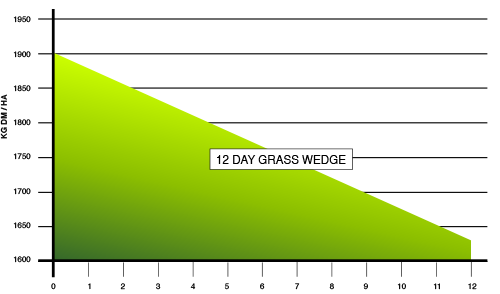How to use nature for maximum Grass Productivity: ‘Maximise Free Solar Money’
 Know the GRASS PRODUCTIVITY
Know the GRASS PRODUCTIVITY
GROWTH CURVE on YOUR Farm.
This graph indicates how the kgDM/ha (kilograms of dry matter per hectare) will fluctuate over a 12 month period.
Passive kgDM/ha is the general reading.
Active kgDM/ha is the recorded farm reading.
How does GRASS PRODUCTIVITY work?

Grass Productivity is all down to timing! When to use which cell is key to maintining your growth productivity.
The Grass Growth Curve clearly identifies the entry and exit levels for the herd/flock into a cell. Each cell will have its own growth curve and each growth curve time period is based on the seasons.
Four Season Timed Grass Productivity Growth Curves

Grass Productivity growth curves could have the following profiles;
April, May, June 19-26 days to get to the entry level, July, August, September, 38 to 62 days October, November, 50 to 85 days. December, January, February, March; 85 to 105 days to get to the entry level.
Number and size of grazing cells is calculated from the above information
12 Day Grass Wedge

Grass Productivity looking for a minimum of 700 kgDM/ha availability
The Grass Productivity wedge indicates the total Grass Productivity of all the cells ranging from target entry height of 2800 to 3200 kgDM to the target exit height 1500 kgDM over a period of 12 days, if Grass Productivity is an excess of 12 days there is the possibility of having excess grass which may lead to losing palatability and nutrients (feed value). If the Grass Productivity wedge shows less than 10 days there is the possibility of running out of grazing in the not too distant future.
REASONS TO BECOME HIGHLY PRODUCTIVE/PROFITABLE GRASS LAND FARMER.
Could the CAP (single farm payment) system be facing the same outcome as the SMP (supplementary minimum prices) subsidy, which formed the backbone of New Zealand farming. Their subsidy formed a significant proportion of the farm income providing up to 40% of their income and the catastrophic financial effects that followed in 1984 when this payment was rapidly phased out. So many farmers in Britain are struggling in spite of receiving a similar subsidy, therefore the urgent need for farmers to re-energize, become more creative and vastly improve existing grazing practices to become profitable, sustainable, successful grass land farmers without having to rely on CAP.
